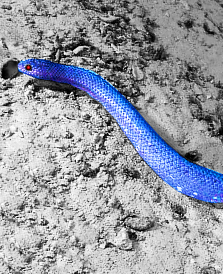Snake spine secrets de-coded for undersea design
 Engineers are once again referring to the great catalogue of nature for their next robotic design.
Engineers are once again referring to the great catalogue of nature for their next robotic design.
University of Adelaide researchers are stealing the best bits from the schematic of the sea snake, as the inspiration for an exciting new marine robot.
The awesome articulation of sea snakes has evolved to help them adapt to life in the water, where the normally land-based reptile has slid its way to the top of the food chain.
Postgraduate mechanical engineering research student Amy Watson and a team of engineering, environmental science and computer science researchers will use the sea snake’s body shape and swimming motion to generate a design for a ‘bio-mimetic’ serpentine robot.
Sea snakes are the only fully aquatic reptiles on the planet. They likely evolved about eight million years ago from an Australian snake that bore live young. Today, most sea snakes are still found in Australia and South-East Asia.
“The success of the sea snake's aquatic invasion is of interest to both evolutionary biologists and mechanical engineers,” Ms Watson said.
“From the more or less cylindrical body with a tapered tail of land snakes, the true sea snakes have become efficient swimmers with ribbon-like bodies and paddle-shaped tails.
“In the transition from land-based to marine vertebrates, sea snakes have acquired remarkable swimming capacity. We want to capture and analyse the body shape and movement to generate information that will enable a more efficient design for underwater vehicles.”
The undulating locomotion of a slithering robot will be much less invasive in the marine environment than a propeller-based machine. Researchers hope it will also be able to move through complex habitats more easily because of its streamlined shape.
“The first step in the process is to learn more about the anatomy of sea snakes and this project starts bone deep - with the spine,” Ms Watson says.
Investigations will be performed on the biomechanics of the sea snake spine, using high-resolution CT scanning and 3D simulations to test movement range.
The range of motion between pairs of vertebrae located at different positions along the spine will be compared along the spine of a single snake and between snakes of different species.
Preliminary results and discussions on the implications of sea snake robot design will be presented this week, at the University of Adelaide-hosted 23rd Australian Conference on Microscopy and Microanalysis (ACMM23) and the International Conference on Nanoscience and Nanotechnology (ICONN 2014). More information is available at the official website.







 Print
Print